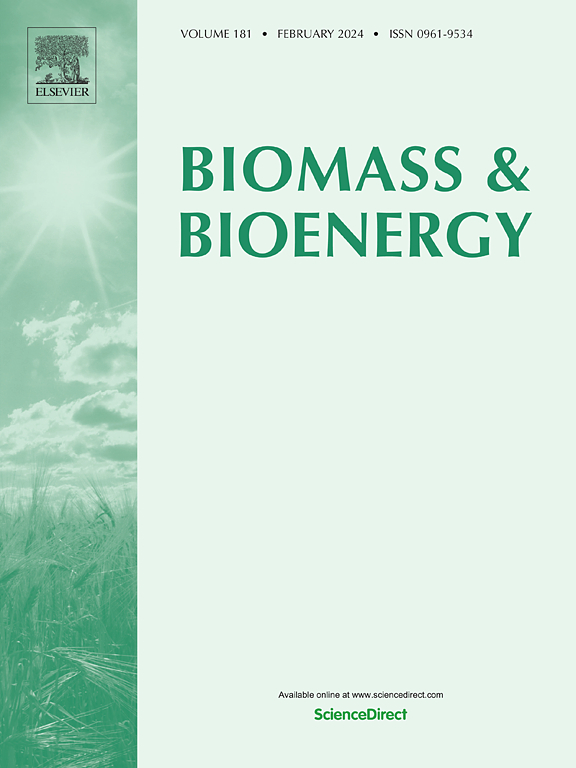以铜冶炼渣为床料的氧载体辅助燃烧半商用燃木循环流化床
IF 5.8
2区 生物学
Q1 AGRICULTURAL ENGINEERING
引用次数: 0
摘要
流化床燃烧(FBC)是瑞典一项成熟的生物质和废物衍生燃料转化技术。最近的研究表明,该工艺可以通过使用含氧床材料来升级,例如以含铁矿物和炉渣的形式。这个概念被称为氧载体辅助燃烧(OCAC),已经证明了在商业锅炉中,使用铁钛矿钛铁矿作为氧载体,可以增强氧的分布和热效率。本研究首次在12mth循环流化床锅炉上大规模利用商业铜渣产品(Järnsand)作为氧载体。通过与Järnsand交换21%至100%的硅砂床,可以成功地将空气与燃料的比率从1.2降至1.08,同时在6% O2浓度约为20 mg/nm3的情况下,CO排放量仍然很低。相比之下,二氧化硅砂床的空气燃料比为1.08,在6% O2条件下,5分钟的平均CO浓度为800 mg/nm3。引入Järnsand后,NO的排放量也减少了约30%。在3.5天的活动中,锅炉在100% Järnsand床上运行,没有任何床料再生。通过Järnsand吸附K, K的浓度达到3.5 wt.-%。没有观测到CO的聚集或增加。没有达到钾饱和,寿命比研究的3.5天更长。综上所述,Järnsand作为OCAC操作中的氧载体具有与钛铁矿相似的性能。本文章由计算机程序翻译,如有差异,请以英文原文为准。
Oxygen carrier aided combustion with copper smelter slag as bed material in a semi-commercial wood-fired circulating fluidized bed
Fluidized bed combustion (FBC) is a well-established technology in Sweden for the conversion of biomass and waste-derived fuels. Recent research has shown that the process can be upgraded by using oxygen-carrying bed material, for example in the form of iron oxide-containing minerals and slags. The concept, called Oxygen Carrier Aided Combustion (OCAC), has demonstrated enhanced oxygen distribution and thermal efficiency in commercial boilers, using the iron-titanium ore ilmenite as oxygen carrier. This study demonstrates the first large-scale utilization of a commercial copper slag product (Järnsand) as oxygen carrier in a 12 MWth circulating fluidized bed boiler. By exchanging between 21 and 100 % of the silica sand bed with Järnsand it was possible to successfully reduce the air-to-fuel ratio from 1.2 down to 1.08 with CO emissions remaining low, at concentrations of around 20 mg/nm3 at 6 % O2. In contrast, an air-to-fuel ratio of 1.08 with silica sand bed gave a 5-min average CO concentration of 800 mg/nm3 at 6 % O2. The NO emissions were also reduced by about 30 % with the introduction of Järnsand. For 3.5 days of the campaign, the boiler was operated with a 100 % Järnsand bed without any bed material regeneration. K was absorbed by Järnsand, and a K concentration of 3.5 wt.-% was reached. No agglomeration or increasing CO emissions were observed. K-saturation was not reached, and a longer lifetime than the studied 3.5 days is suggested. In conclusion, similar performance as ilmenite is suggested for Järnsand as an oxygen carrier in OCAC operation.
求助全文
通过发布文献求助,成功后即可免费获取论文全文。
去求助
来源期刊

Biomass & Bioenergy
工程技术-能源与燃料
CiteScore
11.50
自引率
3.30%
发文量
258
审稿时长
60 days
期刊介绍:
Biomass & Bioenergy is an international journal publishing original research papers and short communications, review articles and case studies on biological resources, chemical and biological processes, and biomass products for new renewable sources of energy and materials.
The scope of the journal extends to the environmental, management and economic aspects of biomass and bioenergy.
Key areas covered by the journal:
• Biomass: sources, energy crop production processes, genetic improvements, composition. Please note that research on these biomass subjects must be linked directly to bioenergy generation.
• Biological Residues: residues/rests from agricultural production, forestry and plantations (palm, sugar etc), processing industries, and municipal sources (MSW). Papers on the use of biomass residues through innovative processes/technological novelty and/or consideration of feedstock/system sustainability (or unsustainability) are welcomed. However waste treatment processes and pollution control or mitigation which are only tangentially related to bioenergy are not in the scope of the journal, as they are more suited to publications in the environmental arena. Papers that describe conventional waste streams (ie well described in existing literature) that do not empirically address ''new'' added value from the process are not suitable for submission to the journal.
• Bioenergy Processes: fermentations, thermochemical conversions, liquid and gaseous fuels, and petrochemical substitutes
• Bioenergy Utilization: direct combustion, gasification, electricity production, chemical processes, and by-product remediation
• Biomass and the Environment: carbon cycle, the net energy efficiency of bioenergy systems, assessment of sustainability, and biodiversity issues.
 求助内容:
求助内容: 应助结果提醒方式:
应助结果提醒方式:


